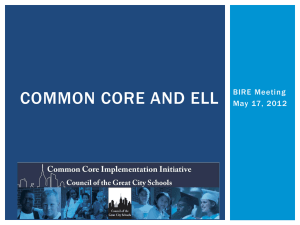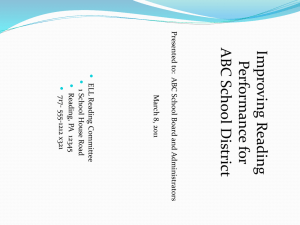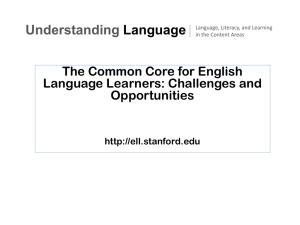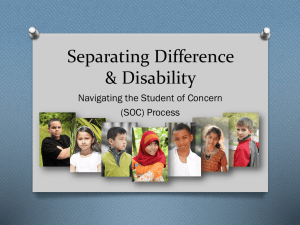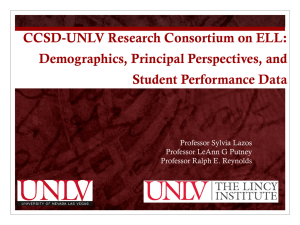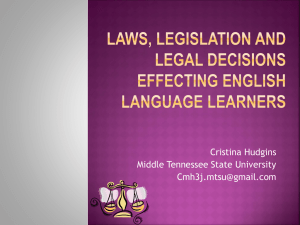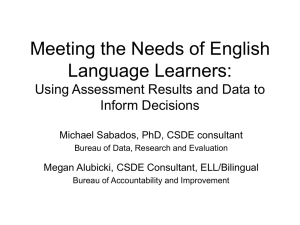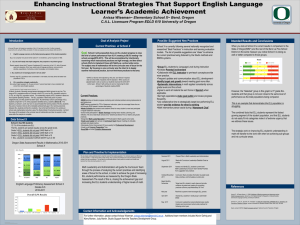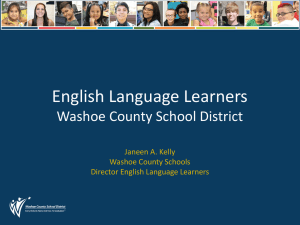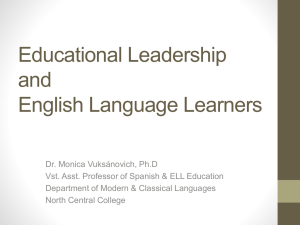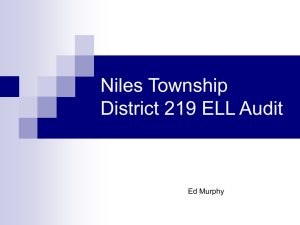Jonathan Gibson - University of Nevada, Reno
advertisement
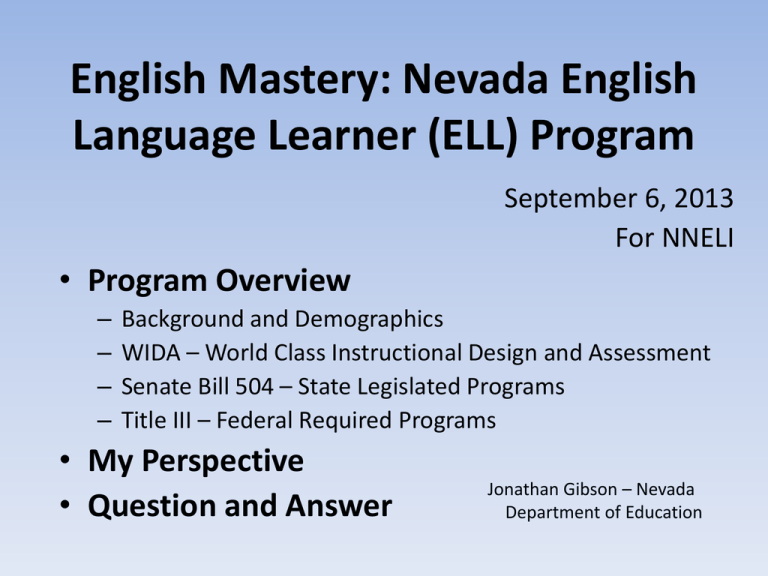
English Mastery: Nevada English Language Learner (ELL) Program September 6, 2013 For NNELI • Program Overview – – – – Background and Demographics WIDA – World Class Instructional Design and Assessment Senate Bill 504 – State Legislated Programs Title III – Federal Required Programs • My Perspective • Question and Answer Jonathan Gibson – Nevada Department of Education Nevada Title III funding – 2011-12 $9,019,735 = federal Title III award $119.47 per ELL pupil allocation to Districts $50,000,000 = SB 504 (2013-2015) $0 Title III money can be used to meet federal requirements to serve ELL students – Title III funds can only be used by Districts to supplement their ELL programs; testing and nearly all staffing must be paid for out of the Districts’ General Funds Nevada ELL Program Snapshot 2010-11 Data 76,517 ELL Identified Students More than 1 out of every 6 (17.5%) of Nevada’s Students Approximately 134,000 identified and former ELL Students Almost 1 in 3 (31%) of Nevada’s Students • 67,754 Hispanic ELL; 101,756 Hispanic not active ELL • 0.1% more Hispanic than White students in Nevada ELL Students Tested and Immigrant Student Counts 90000 80000 70000 60000 50000 40000 30000 20000 10000 0 ELL Tested Immigrant Languages More than 120 different languages spoken 5 most common native languages: Spanish – 88.5% Tagalog – 5.1% Filipino – 2.1% Chinese – 1.6% Vietnamese – 1.2% Who is Identified ELL? Children age 3 to 21 enrolled in school and: Native language is not English; or Home environment includes a language other than English; and/or Speak a language other than English with peers. AND Whose difficulties in Speaking, Reading, Writing or Understanding English may be sufficient to deny: Proficient achievement on State Assessments; Achievement in classrooms instructed in English; Opportunity to participate fully in society. Academic English is the language needed for students to engage with content material and succeed in content classrooms and assessments. If we gave the English Language Proficiency Assessment (ELPA) to ALL students, what percentage would qualify for ELL services? Long-Term ELLs Language Support 4 to 6 years Accomplishment: Percent of Nevada ELL Students Passing the State CRTs 2010-2011 Math CRT Language Arts CRT Current ELL Students 24% 6% Former ELL Students: Less than 2 years since exiting ESL 72.1% 58.7% Total State 68.05% 56.95% Hispanic 61.0% 42.1% Black/African American 56.8% 39.5% Nevada Report Card: NDE Concern: we are just beginning to feel the effects of a surge of Long-Term ELLs in our Secondary schools. LONG TERM ELLS: • Identified ELL for more than 5 years; and • Not made Academic Language Progress for 2 or more years In Clark County, 42% of secondary ELL students are Long-Term ELLs (2011-12) Combined data from Washoe and Clark County: 60.6% of secondary ELL students are credit deficient (2011-12) How does this happen? What are the solutions? WIDA in a Nutshell: 34 state consortium – and growing Directed by the States – University of Wisconsin Standards: The Language of: Language Arts Math Social Studies Science Academics – school Assessment System WIDA Standards match academic content with language supports for given language proficiencies Common Core + WIDA + CCSSO (language framework) => content mastery + academic language SB 504 in a Nutshell: Clark and Washoe: Zoom Schools - fully funded: Pre-K Full day K Reading Centers Summer Programs Remaining Districts Apply for Specific Programs English Mastery Council - Recommend: Criteria for …and Review District ELL Plans TESL Endorsement Criteria – including who… TESL Higher Ed Courses of Study (curriculum) State English Language Development Standards Title III in a Nutshell: NO CHILD LEFT BEHIND – NCLB T3 – not relieved under the Waiver • AMAO I (progress), II (achievement) and III (content achievement) Nevada School Performance Framework: T1 has new targets for ELL, SpEd, FRL Office for Civil Rights (and NCLB) - Program: Identify ELLs Develop a Program Ensure staff, materials and facilities Develop English assessment and exit criteria Evaluate and improve program Department of Justice – Performance Elementary and Middle Schools — Index Point Weighting — Subpopulation Growth Gap Reduction 20% Other Indicator(s) 10% Proficiency 30% Student Growth Percentiles 40% 18 High School Index Point Weighting Other Indicator 14% College & Career Readiness 16% Growth and Proficiency 30% Subpopulation Subpopulation Proficiency Gaps Graduation 10% Gaps Graduation 15% 15% 19 Title III Compliance does not secure OCR and DOJ Compliance! DOJ OCR Title III NCLB In addition to program compliance, student performance outcomes factor. So, what does all of this mean if you are an ESL teacher? ELL Program Objectives: ELL students will: • Develop Academic English Proficiency; • Successfully master content requirements; • Meaningfully engage with teachers, peers, and content material in the classroom setting; • Graduate with the ability to continue post-secondary education/workforce training. What does it all mean? To me it means: You have an opportunity of a life-time! • Significant interest from legislators and instructional leaders… • Significant range of understanding to (significant) misunderstanding… • Significant NEED, and… • …. • Significant return on your investment!!
